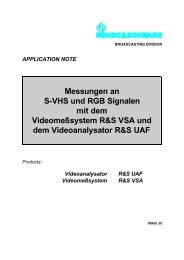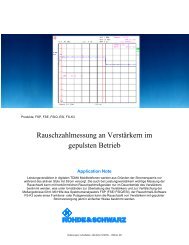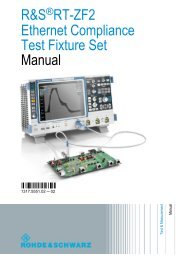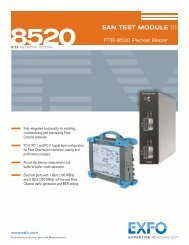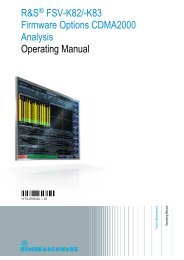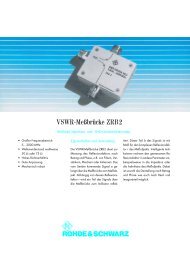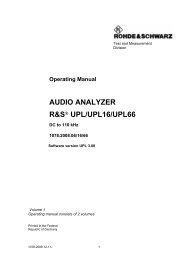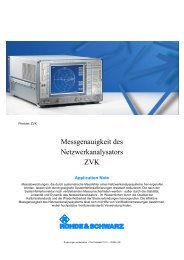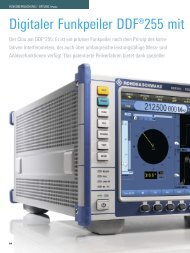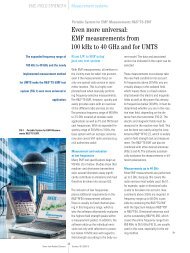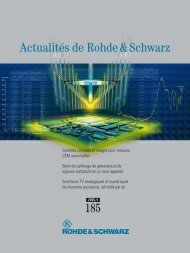ASCII Conversion of Binary Data from Test Receiver for Generation ...
ASCII Conversion of Binary Data from Test Receiver for Generation ...
ASCII Conversion of Binary Data from Test Receiver for Generation ...
Create successful ePaper yourself
Turn your PDF publications into a flip-book with our unique Google optimized e-Paper software.
1. INTRODUCTIONThe models with built-in monitor <strong>of</strong> the ESXS family <strong>of</strong> test receivers as well as the instruments ESN,ESVN and ESCS incorporate a 3 ½" micr<strong>of</strong>loppy disk drive. The floppy serves as a mass memory <strong>for</strong>instrument settings and test results. The data are stored on the disk in the internal, binary ESXS <strong>for</strong>mat,which saves space and time but does not allow external evaluation <strong>of</strong> data.2. PROBLEM:Processing <strong>of</strong> <strong>Binary</strong> <strong>Data</strong> on PCIt is frequently desired to process the results stored on the floppy on a PC, eg <strong>for</strong> the generation <strong>of</strong>customer-specific test reports by means <strong>of</strong> a word processing system. To enable processing on anexternal PC, the binary data usually need conversion into an <strong>ASCII</strong> <strong>for</strong>mat. This is possible by means <strong>of</strong>the ESXS2ASC.EXE program, which is described under 4. below. The program is available free <strong>of</strong>charge <strong>from</strong> your Rohde & Schwarz representative.The ESXS2ASC.EXE program does not convert all the data stored on the floppy but essentially thoseneeded <strong>for</strong> receiver-generated test reports on a printer or plotter. The documentation generated on anexternal PC using the converted data thus corresponds to the report generated directly by the receiveritself.To evaluate further data stored on the floppy, eg the instrument settings, a C program can be generated.The data declarations required <strong>for</strong> this are described in files LLI.XH, TDF.XH, TDS.XH, RES.XH,SPS.XH and SYSDFS.H, which are also contained in file E109053.EXE.Graphics can be stored on the floppy in the <strong>for</strong>m <strong>of</strong> <strong>ASCII</strong> files in HP-GL <strong>for</strong>mat (key entries on receiverfront panel: FLOPPY ⇒ s<strong>of</strong>tkey STORE ⇒ s<strong>of</strong>tkey HP-GL FILE). They are thus suitable <strong>for</strong> furtherprocessing and will not be discussed here.3. <strong>Data</strong> Stored on FloppyThe data stored on the floppy are in six <strong>for</strong>mats identified by different extensions:Format *.RES:• receiver settings (including special functions, scan data, options and settings <strong>for</strong> reports)• activated limit lines• activated transducer factor• transducer set (with factors belonging to activated set)• test results including:• all results obtained in previous scan (level/1st detector, level/2nd detector, validity byte)• all (max. 400) subrange maxima <strong>of</strong> both detectors (frequencies, levels, limit lines exceeded)• all (max. 400) results obtained in follow-up measurements, if any (frequencies, levels, phaseangles)• scan data sets used <strong>for</strong> measuring the dataFormat *.SPC:Format *.LLI:Format *.TDF:Format *.TDS:Format *.GRA:corresponds to *.RES <strong>for</strong>mat except <strong>for</strong> scan resultslimit linestransducer factorstransducer set with active factorsscan results in HP-GL <strong>for</strong>matFormats *.SPC, *.LLI, *.TDF and *.TDS are contained in *.RES.1EE21_4L.DOC 2 17 November 1997



